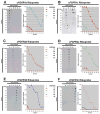Detection of isoform-specific fibroblast growth factor receptors by whole-mount in situ hybridization in early chick embryos
- PMID: 21465617
- PMCID: PMC3092825
- DOI: 10.1002/dvdy.22616
Detection of isoform-specific fibroblast growth factor receptors by whole-mount in situ hybridization in early chick embryos
Abstract
We have developed "b" and "c" isoform-specific chicken fibroblast growth factor (FGF) receptor 1-3 probes for in situ hybridization. We rigorously demonstrate the specificity of these probes by using both dot blot hybridization and whole-mount in situ hybridization during neurulation and early postneurulation stages, and we compare expression patterns of each of the three isoform-specific probes to one another and to generic probes to each of the three (non-isoform-specific) FGF receptors. We show that the expression pattern of each receptor is represented by the collective expression of each of its two isoforms, with the expression of each FGF receptor being most similar to that of its "c" isoform at two of the three stages studied, and that tissue and stage differences exist in the patterns of expression of the six isoforms. We demonstrate the usefulness of these probes for defining the differential tissue expression of FGF receptor 1-3 isoforms.
Copyright © 2011 Wiley-Liss, Inc.
Figures





Similar articles
-
Expression of the fibroblast growth factor-2 isoforms and the FGF receptor 1-4 transcripts in the rat model system of Parkinson's disease.Neurosci Lett. 2004 Apr 29;360(3):117-20. doi: 10.1016/j.neulet.2004.01.046. Neurosci Lett. 2004. PMID: 15082147
-
Temporal and spatial expression of FGF ligands and receptors during Xenopus development.Dev Dyn. 2009 Jun;238(6):1467-79. doi: 10.1002/dvdy.21913. Dev Dyn. 2009. PMID: 19322767 Free PMC article.
-
Spatial and temporal expression patterns of FGF receptor genes type 1 and type 2 in the developing chick retina.Exp Eye Res. 1994 Mar;58(3):351-8. doi: 10.1006/exer.1994.1025. Exp Eye Res. 1994. PMID: 8174655
-
Different members of the fibroblast growth factor receptor family are specific to distinct cell types in the developing chicken embryo.Dev Biol. 1993 Jan;155(1):107-23. doi: 10.1006/dbio.1993.1011. Dev Biol. 1993. PMID: 8416827
-
In situ hybridization analysis of chick embryos in whole-mount and tissue sections.Methods Cell Biol. 2008;87:169-85. doi: 10.1016/S0091-679X(08)00209-4. Methods Cell Biol. 2008. PMID: 18485297 Review. No abstract available.
Cited by
-
FGF2 delays tectal neurogenesis, increases tectal cell numbers, and alters tectal lamination in embryonic chicks.PLoS One. 2013 Nov 12;8(11):e79949. doi: 10.1371/journal.pone.0079949. eCollection 2013. PLoS One. 2013. PMID: 24265789 Free PMC article.
-
Expression of hindbrain boundary markers is regulated by FGF3.Biol Open. 2012 Feb 15;1(2):67-74. doi: 10.1242/bio.2011032. Epub 2011 Nov 1. Biol Open. 2012. PMID: 23213398 Free PMC article.
-
The Multiple Roles of FGF Signaling in the Developing Spinal Cord.Front Cell Dev Biol. 2017 Jun 2;5:58. doi: 10.3389/fcell.2017.00058. eCollection 2017. Front Cell Dev Biol. 2017. PMID: 28626748 Free PMC article. Review.
-
Expansion, folding, and abnormal lamination of the chick optic tectum after intraventricular injections of FGF2.Proc Natl Acad Sci U S A. 2012 Jun 26;109 Suppl 1(Suppl 1):10640-6. doi: 10.1073/pnas.1201875109. Epub 2012 Jun 20. Proc Natl Acad Sci U S A. 2012. PMID: 22723357 Free PMC article.
-
An efficient mRNA display protocol yields potent bicyclic peptide inhibitors for FGFR3c: outperforming linear and monocyclic formats in affinity and stability.Chem Sci. 2024 Mar 18;15(16):6122-6129. doi: 10.1039/d3sc04763f. eCollection 2024 Apr 24. Chem Sci. 2024. PMID: 38665530 Free PMC article.
References
-
- Bell GW, Yatskievych TA, Antin PB. GEISHA, a whole-mount in situ hybridization gene expression screen in chicken embryos. Dev Dyn. 2004;229:677–687. - PubMed
-
- Böttcher RT, Niehrs C. Fibroblast growth factor signaling during early vertebrate development. Endocr Rev. 2005;26:63–77. - PubMed
-
- Chapman SC, Schubert FR, Schoenwolf GC, Lumsden A. Analysis of spatial and temporal gene expression patterns in blastula and gastrula stage chick embryos. Dev Biol. 2002;245:187–199. - PubMed
-
- Darnell DK, Kaur S, Stanislaw S, Davey S, Konieczka JH, Yatskievych TA, Antin PB. GEISHA: an in situ hybridization gene expression resource for the chicken embryo. Cytogenet Genome Res. 2007;117:30–35. - PubMed
Publication types
MeSH terms
Substances
Grants and funding
LinkOut - more resources
Full Text Sources

